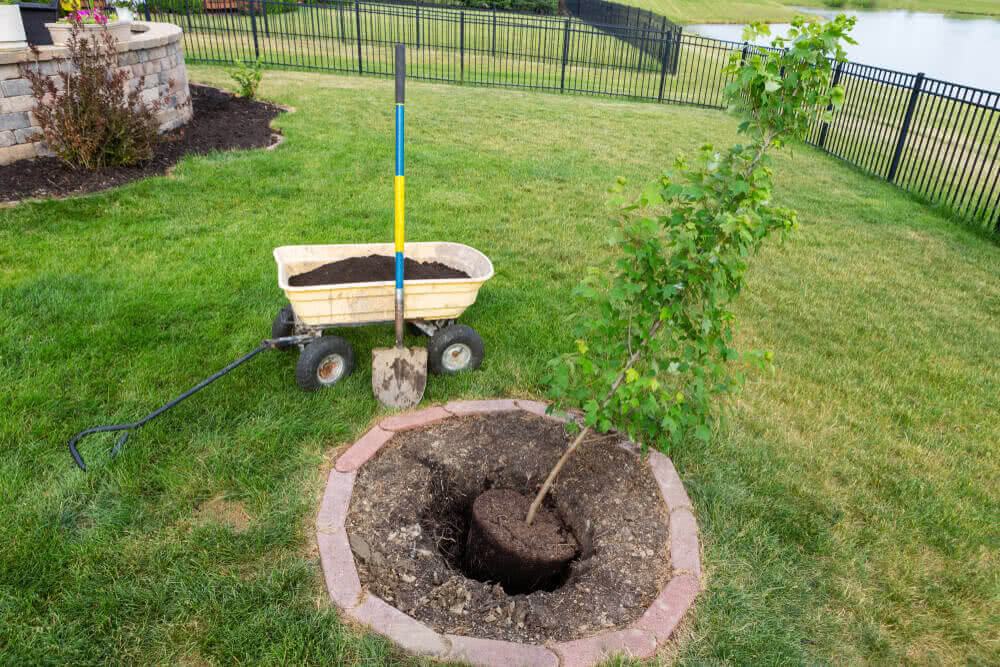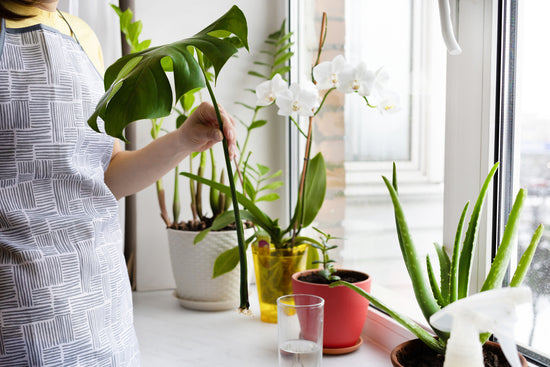Exhalation of moisture from the leaves of plants goes on most rapidly when the atmosphere is dry and the sky cloudless; therefore, for plants in foliage, if the transplanting cannot be done in moist, cloudy weather, these conditions should be secured by shade and frequent sprinkling with water.
If possible, all plants should be transplanted with a mass of soil above the roots. Some plants which have large woody roots and few fibrous roots near the stem, such as rose trees that have been growing for some years in the same place, it is of little use lifting a ball of soil with the plant. It should be dug out carefully, keeping the roots as entire as possible, carried to its new site, where the hole should be prepared at least twice as large as the roots require. Read about how should I repot my old plants?

After placing the tree in the hole, it is essential that the roots be kept in their natural positions, and not twisted or bent in any way. If any roots have been broken, they should be cut off with a sharp knife and the soil carefully placed among the roots, so that all the interstices may be filled entirely. As the filling up progresses, the soil should be trodden thoroughly at short intervals, to make it very firm throughout the whole mass.
Manure should never be placed immediately on the roots of a plant; some fine soil should be placed on the roots first, then manure may be put in and covered with soil. In transplanting trees, it is beneficial to prune away a number of the smaller branches, and especially any green shoots, which would probably die in any case. By this means the stomata through which exhalation goes on are diminished, and the plant gives up less of its moisture.

The newly planted tree must be supported against swaying wind, otherwise it cannot strike root. For large trees three ropes or wires fastened to strong pegs driven into the ground like tent ropes maybe necessary, but for anything under 6 feet in height, the stems of Veda-ouse, a large sugar cane like grass (Saccharum procerum), played on 3 sides at a distance of 2 feet from the newly planted tree, and joined to it near the top by plantain fibre bands, are most effectual, and can be pulled as soon as the tree has formed roots.
Below is the list of trees that may be transplanted when they are large in size is mentioned below:

Season for transplanting large trees:
November and December are favourable months for transplanting large trees. The rainy season is not recommended for this work, because it is scarcely practicable to keep lately transplanted large trees steady during that season. The hot season also has gales and is otherwise objectionable. Read about 5 ways to prevent soil erosion during monsoon.
If the tree to be transplanted is tap-rooted, a circular trench, wide enough for the men to work in, must be dug at a distance of two feet from the stem at the surface and gradually approaching the centre as it descends, until the “ball” of earth is the shape of an inverted cone. To the sides of the ball of earth thin boards 4 inches wide, should be carefully arranged and fastened by ropes twisted to become very tight.

A tree-lifter must be at hand, consisting of a pair of sturdy wheels and axle and two sturdy poles six inches in diameter at the thicker end, and twenty feet long. About four feet from the thick ends these poles should be fastened to the axle, the small ends being tied together firmly.
The lifter is then backed up to the tree, the short ends of the poles fastened to the sides of the ball of earth, the long-term depressed, and the tree lifted. The hole is then filled up with soil, and the tree is placed on the filled in the earth, a new grip lower down is taken, so that the tree may run free from the ground.
If the distance the tree has to be carried is short, it may be kept erect ; but if the distance is considerable and telegraph wires or bridges are to be passed, it is better to let the tree fall gently across the axle, care being taken that sacking or some other protection is given to the bark.
Cypress trees are not tap-rooted, but the roots are fine and wiry; therefore a ball of the earth should invariably be taken with them. Cypress trees thirty feet high are well worth transplanting; with ordinary skill, there is little danger of loss, and the immediate effect produced is valuable.

Trees with spreading roots, such as the Gul Mohr {Poinciana regia), and Millingtonia cannot be lifted with a ball. It is better to begin digging round such trees at a distance of four feet and cut clean off all roots that pass that line, remove all the soil, and lift as described above. Drag root first by bullocks; men were stationed to keep the head from rubbing on the ground.
In planting keep the tree in the same position with regard to the sun as it previously had. If the opposite side is turned towards the sun, great scars may form on the stem and branches on the side exposed to the sun. To fill in around the root use moist—not wet—soil, and pack it among the roots firmly and carefully. Manuring at this stage is not advisable: water thoroughly at once and keep the soil moist for some months afterwards. Fasten the trees firmly by ropes to prevent swaying by the wind.
Cost of Transplanting Large Trees:
- Whether transplanting large trees is profitable or not depends on the time within which the desired effect is wanted. It certainly is costly at first.
- A tree thirty feet high and weighing a ton cannot be transplanted a distance of a mile for less than Rs.20
- Whether it is more than the cost of planting a young tree and attending it for several years is doubtful, and local conditions must be considered before transplanting.
- To avoid care and anxiety select small trees, especially when planting is done for economic purposes.
- Cypress trees which have been raised from cuttings and transplanted several times when young, have usually wiry roots, and may be transplanted with a ball of earth at the root. Trees of this kind, 30 feet in height are worth transplanting.
- Palm trees of certain genre, such as date tree and the coconut tree, and others which show a disposition to produce roots from the stem, may have a large box built round the stem six inches from the ground, filled with very rich soil and watered regularly.
- When the box is full of roots, the stem may be cut beneath box and the palm safely carried away.

Sourced from the book: Gardening in India by G Marshall Woodrow










